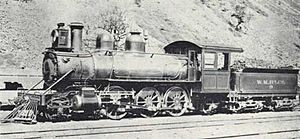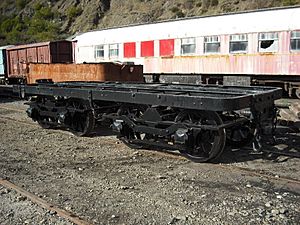Wellington and Manawatu Railway Trust facts for kids
Quick facts for kids WMR No.9 |
|
 |
|
| No. 9 at Paekākāriki, c. 1900. | |
| Power type | Steam |
|---|---|
| Builder | Baldwin Locomotive Works |
| Build date | 1891 |
| Configuration | 2-6-2 |
| Gauge | 3 ft 6 in (1,067 mm) |
| Wheel diameter | 4 ft 1 in (1 m) |
| Locomotive weight | 50.8 t (50.0 long tons; 56.0 short tons) |
| Fuel type | Coal |
| Boiler pressure | 140 lbf/in2 (970 kPa) |
| Cylinder size | 15 in × 20 in (381 mm × 508 mm) diameter × stroke |
| Power output | 437 hp (326 kW) |
| Tractive effort | 10,260 lbf (45.6 kN) |
| Retired | 13 November 1926 |
| Current owner | Wellington and Manawatu Railway Trust |
| Disposition | Under Restoration |
The Wellington and Manawatu Railway Trust is a charity based in Wellington, New Zealand. This group is working hard to bring an old steam train, Locomotive No. 9, back to life. This train used to belong to the Wellington and Manawatu Railway. Later, when the government owned it, its number changed to N 453. The Trust's goal is to make sure this historic locomotive can run again.
Contents
About the Trust
The Wellington and Manawatu Railway Trust was created to find and fix up Locomotive No. 9. This steam engine was built by Baldwin in 1891. It has a special wheel setup called 2-6-2. The Trust has already found the locomotive parts. Now, they are busy putting them back together.
While No. 9 is their main focus, the Trust also cares about other old items from the Wellington and Manawatu Railway. These items have survived over the years. The Trust also owns an old 4-wheel wagon from the same railway. This wagon is currently kept at the Silver Stream Railway in Upper Hutt. Locomotive No. 9 is the only known train from the Wellington and Manawatu Railway that still exists.
Meet Locomotive No. 9
Locomotive No. 9 was built in 1891 by the Baldwin Locomotive Works in Philadelphia. Its special number from the builder was 12104. This engine was one of two trains made for the Wellington and Manawatu Railway. It was given the number 9. Its sister train was No. 10.
These two trains were very similar to the NZR N class trains built in 1885. But No. 9 and No. 10 had some differences. They had longer smokeboxes and spoked wheels. They also did not have air brakes at first. These trains were kept at the WMR's Paekākāriki depot. They mostly pulled trains with both passengers and goods. They ran on the easy part of the track between Paekākāriki and Longburn. In 1892, No. 10 set a world speed record for its track size. It reached 64.4 mph (103.6 km/h). This showed how powerful these trains were.
In 1901, both No. 9 and No. 10 got new Westinghouse air brakes. This was part of the company's plan to add continuous brakes to all its trains. This project finished in 1902. Other changes to the trains were small. For example, their original funnels were replaced with cast iron ones.
In December 1908, the New Zealand Government bought the Wellington and Manawatu Railway. The railway became part of the government's train system. Locomotive No. 9 was then renamed N 453. Its WMR signs were removed, and new NZR number plates were added. The train also got tablet hooks on its cab and a standard NZR smokebox front.
No. 9 stayed at Paekākāriki until 1916. Then, it was sent to Greymouth in the South Island. There, it pulled mail trains between Greymouth and Otira. Its wooden cab was replaced with a steel one. Kerosene lights were also changed to acetylene lights. In the early 1920s, it was used for moving trains around and helping them up hills in Otira. For this job, N 453 got special sanding equipment and a tender-cab. Its tender coal flare was cut off, and ladders were added to reach the tender body. In 1925, N 453's old boiler was replaced with a new one built by NZR.
However, in November 1926, No. 9 was taken out of service. It was taken apart and dumped into the Bealey River on the Midland Line. This was done to stop the river from washing away the railway track. We do not know why the train was removed from service. But all useful parts were taken off the train. For example, its boiler was later used on another train, Wb 300.
Finding and Recovering the Engine
By the end of the 1900s, most old train parts in the Bealey River valley were gone. They had been scrapped or buried to protect the river. No. 9 was the only engine left untouched. But its future was uncertain.
In 2003, the Trust started to get the parts of No. 9 from the river. The train had been dumped near Arthur's Pass in November 1926. This was done to make the railway bank stronger and stop floods. The first part found was the train's frame and cylinders. These were taken by truck to the Canterbury Steam Preservation Society in Christchurch. In 2006, the train's tender, truck frames, and other parts were found. They were also trucked from the dump site to be stored with the frame.
On February 26, 2007, all the parts were moved to Steam Incorporated in Paekākāriki. This is where the old WMR depot was, where No. 9 used to be based. This is where the restoration work began. It is unlikely that there are any more valuable parts of No. 9 left at the dump site. The original boiler from No. 9 was found at the Oxford Boiler Dump. However, it is too damaged to be saved and used again.
Restoring the Locomotive
In 2006, the Trust made an agreement with Steam Incorporated. Once No. 9 was moved there, the restoration work started seriously. The first step was to fix the tender, which is the part that carries coal and water. After that, they would work on the main locomotive. As part of the agreement, No. 9 is being restored to a high standard. This means it can be used on the national rail network.
The Trust has found many parts for the locomotive. However, a brand new boiler will be needed. It is also likely that new driving wheels will have to be made. This is because no driving wheels were found with the locomotive from the dump site. By May 2009, the tender frame and its bogies (wheel sets) were fully rebuilt. They were put back together.
Other Projects
The Wellington and Manawatu Railway Trust also owns an old 4-wheel wooden wagon. This wagon is from the WMR era. It is currently stored at the Silver Stream Railway in Upper Hutt. The exact type of this wagon is still being identified. However, the Trust plans to restore this wagon in the future.
See also
- Railway preservation in New Zealand
- Wellington and Manawatu Railway
- NZR N class


